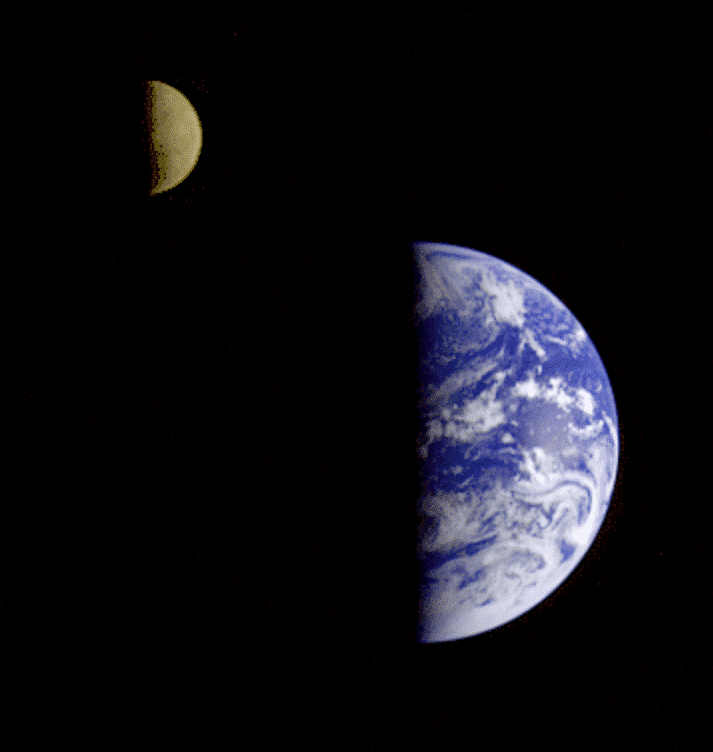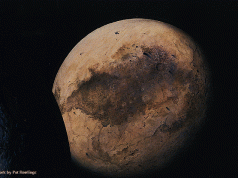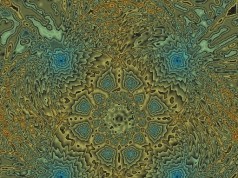Imagination ought to be stronger than cognition: such is human genius.
Luna, or Moon, played a crucial role in the rise of life on Earth. It is rather unlikely that advanced life could have evolved without it. Luna provided tremendous chemical mixing and unlikely stability. Simultaneously.
Luna allows the rotation of the Earth to be close to perfection. Other planets have unstable rotation (with up to a 40 degrees wobbling axis: Mars), or insufficient spins (Mercury, Venus), or lay completely flat on the ecliptic plane like beached whales (Uranus). The angular momentum of the Earth-Moon system is one, yet it’s spread on a huge area (about 1/6 of the Sun’s cross section). Luna used to graze the Earth, at the Roche Limit, causing kilometer tides flushing continental margins continually (thus mixing organic materials with earth, sea and sky, as in an infernal organic materials churning reactor).
How did Luna form?
John Kennedy’s Apollo Project sent geologists to the Moon, and brought back precious rocks that were generously divided among laboratories worldwide.
Exploring the Moon was a better use of money than feeding the starving in Africa. Indeed there were no wars among the savages, yet, hence no starving in Africa, yet. Moon exploration also demonstrated that the USA does not have to be a nasty den of pirates 100% of the time.
First verdict of Moon science? Isotopic studies (2001) confirmed that Luna is made of Earth’s mantle rocks.
The surprise was considerable. Before that discovery, it was widely expected that Luna was a captured minor planet. Instead, the Earth and Moon came from the same body. How could that be? The obvious scenario was that a Mars size object hit the Earth. Melted debris would have gathered around Earth, and coalesce, forming the Moon. George Darwin, fifth child of the most famous Darwin, a distinguished astronomer, suggested this in 1898.
If Luna was made of Terra, it was not made from an impact (because what happened tot he impactor’s material? Luna’s titanium isotope ratio (50Ti/47Ti) is so close to the Earth’s (within 4 parts per million), that none of the impactor’s mass could have been part of the Moon ).
Moreover there is another drastic problem with the impact hypothesis. The dynamics don’t work. A grazing impact would have resulted with debris in a highly eccentric, grazing ellipse. Such a very elongated ellipse is not observed, and impossible to imagine (the debris would have crashed back to Earth, either from air resistance, or the Roche Limit). We are left with a deeper oblique impact, where the impactor is fully absorbed. But then it’s unclear that we can get massive ejecta with a required speed of ten kilometers per second or so, plus high enough an altitude to escape the Roche Limit.
All the more as astronomical considerations lead one to believe the collision happened at low speed (at most 4 kms/s).
Still another problem of the impact theory is that it implies that the entire planet would have melted. However, there is plenty of evidence that the planet did not entirely melt. Rocks (zircons) have been found to be 4.375 billion years old, plus or minus 6 million years! These are granite like, water rich rocks. That means the supposedly melted Earth would have become solid within 100 million years of impact (by contrast those who believe Earth Core has just residual heat, no active fission heat, claim the core cools at the rate of 100 degrees Celsius every billion years. They generally also believe in the Impact, and thus contradict themselves, thanks to the zircons!)
Thus the impact theory does not work.
The basic problem is that the Moon was created from Earth. Imagine the Earth as a soup: you need to put part of the soup in orbit. You need to rocket it up.
Any brighter idea? I propose there was no magma soup (because so was the fact). I propose the nuclear explosions theory. Wow. I replace the overall melting of the impact theory, by powerful local explosions that could hurtle water rich rocks in orbit. As I pointed out in “Life Giving Earth Nuclear Reactor”, we (probably) have below our feet the largest fission reactor in the known universe.
The Inner Core of Earth is about 70% of the size of the Moon, 2440 kilometers across. It is also around 5,800 Degrees Kelvin, the temperature of the surface of the Sun. Should the rest of the planet become transparent, it would appear to us about 35 wider than the Sun, and just as bright. That would transfer to us about 1,000 times more energy than the Sun does. We would quickly fry.
In my vision of Earth’s genesis, a lot of radioactive fission products were gathered. Being denser, they sank in molten Earth. As they did so, their neutrons hit each other. Nuclear fission pockets formed, and violently erupted in tremendous nuclear explosions, deep inside the Earth’s mantle.
(In most so called thermonuclear bombs’ explosions, contrarily to Communal Wisdom, most of the power actually comes from fission, by using the cheap trick that Uranium 238, the “stable” isotope of Uranium, fissions when exposed to fast neutrons; in the young Earth, there would have been plenty of Uranium 238; this subtlety no doubt escaped geophysicists, since they are unused to nuclear bomb making. In other words, tapping my nuclear know-how, I notice that there is way more fissionable nuclear fuel down below if one thinks, not as Voltaire’s proverbial watch maker, but as a nuclear bomb maker! Is not thinking fun? The reserves of U238 inside the Earth are enormous, and were more than double that, 4.5 billion years ago).
These enormous nuclear explosions, within the mantle, created plenty of ejecta, thank you Lord. Most fell back with a splash, but plenty had enough correctly directed momentum to achieve high enough orbit.
This is smarter than it looks. The Earth rotated at least once every five hours (8,000 kilometers/hour). That means ejecta thrown up at the equator would have had one third of the energy needed for satellization. Hence only equatorial ejecta would have formed the Moon, explaining both why the Moon’s orbit is coplanar, and Luna spins the way it does.
The hot debris gathered, and formed the Moon, just beyond Édouard Roche’s (liquid) Limit. At least, so I propose. Never underestimate all things nuclear.
Some will object that the theory above does not explain the high angular momentum of the Earth-Moon system, that an impact provides with. They will object that I have to introduce this as an independent assumption.
It is true that, the more the independent assumptions in a theory, the weaker it is, or the more empirical.
The Nuclear Core Theory (NCT) explains a lot of characteristics of the Earth. Could it also explain the high angular momentum? Yes. How? NCT considers that Earth formed not just in the Habitability Zone, but in a Nuclear Zone (NZ). The NZ cloud dust was full of heavy elements. Heavy nuclei can’t be held together by the nuclear force, so they fission, So the densest elements are radioactive.
As the NZ condensed, the heavy elements carried more angular momentum (angular momentum is the product of speed by mass by radius). So any planet in an NZ (which I believe necessary for long term life evolution), once it has condensed from an NZ cloud, will have more angular momentum. The NCT implies high angular momentum.
Reality is stronger medicine than fiction, because what’s within is a pale imitation of interpreted fragments out there that it has been our good fortune to come across.
Conscience without science is only dwarfing of the soul.
Patrice Ayme
Note: Angular momentum could have augmented further with idiosyncratic details: the nukes could have accelerated the Earth rotation, or an impact could have aggravated the nuclear fission explosions.






